headlights OLDSMOBILE SILHOUETTE 1993 Owners Manual
[x] Cancel search | Manufacturer: OLDSMOBILE, Model Year: 1993, Model line: SILHOUETTE, Model: OLDSMOBILE SILHOUETTE 1993Pages: 323, PDF Size: 17.13 MB
Page 47 of 323
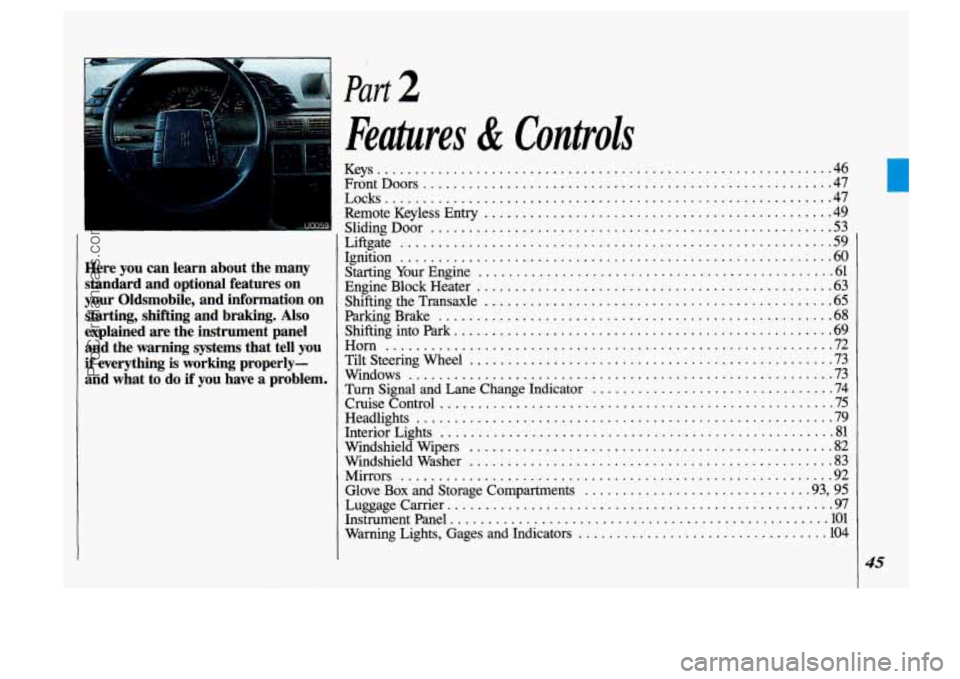
v..
.
Here you can learn about the many
standard and optional features on
your Oldsmobile. and information on starting. shifting and braking
. Also
explained are the instrument panel and the warning systems that tell you
if everything is working properly-
and what
to do if you have a problem .
Part 2
Features & Controls
Keys 46
FrontDoors
...................................................... 47
Remote Keyless Entry
.............................................. 49
Sliding Door 53
Liftgate
......................................................... 59
Ignition
......................................................... 60
Starting Your Engine
............................................... 61
Shifting the Transaxle
.............................................. 65
..........................................................
Locks ........................................................... 47
.....................................................
EngineBlockHeater ............................................... 63
ParkingBrake
.................................................... 68
Shiftingintopark
.................................................. 69
Horn ........................................................... 72
Windows
........................................................ 73
TiltSteeringWheel
................................................ 73
Turn Signal
and Lane Change Indicator ................................ 74
CruiseControl .................................................... 75
Headlights
....................................................... 79
Windshield Wipers
................................................ 82
Windshield Washer
................................................ 83
Mirrors
......................................................... 92
Glove
Box and Storage Compartments ............................. .93, 95
Luggagecarrier
....................................................
Instrument Panel .................................................. 101
Warning Lights, Gages and Indicators
................................. 104
InteriorLights
.................................................... 81
I'
45
L
ProCarManuals.com
Page 76 of 323
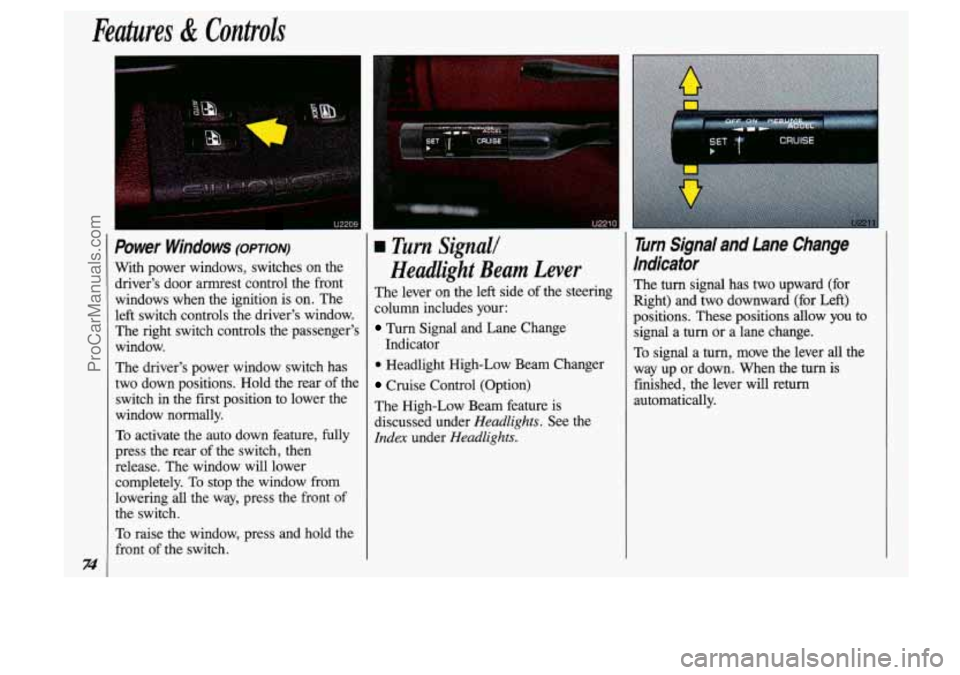
Features & Controls
74
I
Power Windows (omon)
With power windows, switches on the driver's door armrest control the front
windows when the ignition is on. The
left switch controls the driver's window. The right switch controls the passenger's
window.
The driver's power window switch has
two down positions. Hold the rear of the
switch
in the first position to lower the
window normally.
To activate the auto down feature, fully
press the rear of the switch, then
release. The window will lower
completely.
To stop the window from
lowering
all the way, press the front of
the switch.
To raise the window, press and hold the
front of the switch.
u2210
a Turn Signall
Headlight Beam Lever
The lever on the left side of the steering
column includes your:
Turn Signal and Lane Change
Indicator
0 Headlight High-Low Beam Changer
Cruise Control (Option)
The High-Low Beam feature is
discussed under
Headlights. See the
Idex under Headlights.
r CRUISE
I
Turn Signal and Lane Change
Indicator
The turn signal has two upward (for
Right) and two downward
(for Left)
positions. These
positions allow you to
signal a
turn or a lane change.
To signal a
turn, move the lever all the
way up or down. When the
turn is
finished, the lever will
return
automatically.
ProCarManuals.com
Page 81 of 323
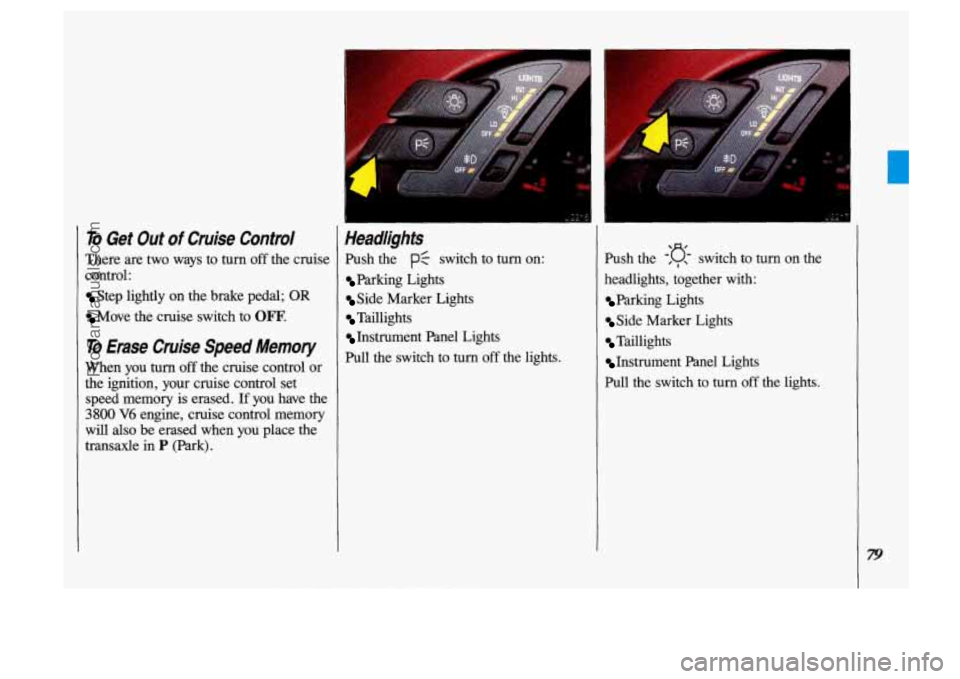
To Get Out of Cruise Confro/
There are two ways to turn off the cruise
control:
Step lightly on the brake pedal; OR
Move the cruise switch to OFF.
To Erase Cruise Speed Memory
When you turn off the cruise control or
the ignition, your cruise control set
speed memory is erased.
If you have the
3800 V6 engine, cruise control memory
will also be erased when you place the
transaxle
in P (Park).
Headlights
Push the PC switch to turn on:
Parking Lights
Side Marker Lights
Taillights
Instrument Panel Lights
Pull the switch to
turn off the lights. Push the
-'D , , switch to turn on the
headlights, together with:
Parking Lights
Side Marker Lights
Taillights
Instrument Panel Lights
Pull the switch to turn
off the lights.
ProCarManuals.com
Page 82 of 323
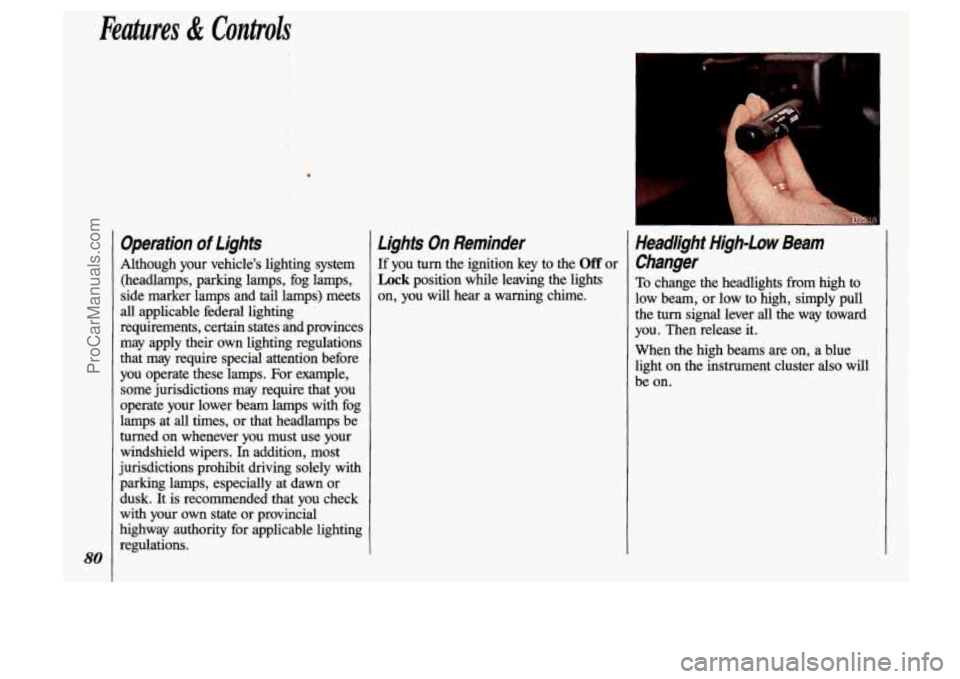
Features & Controls
80
Operation of Lights
Although your vehicle’s lighting system (headlamps, parking lamps, fog lamps,
side marker lamps and tail lamps) meets
all applicable federal lighting
requirements, certain states ahd provinces
may apply their own lighting regulations
that may require special attention before
you operate these lamps. For example,
some jurisdictions may require that you
operate your lower beam lamps with fog
lamps at all times, or that headlamps be
turned on whenever you must use your
windshield wipers. In addition, most
jurisdictions prohibit driving solely with parking lamps, especially at dawn or
dusk. It is recommended that you check
with your own state or provincial
highway authority for applicable lighting
regulations.
Lights On Reminder
If you turn the ignition key to the Off or
Lock position while leaving the lights
on, you will hear a warning chime.
I
Headlight High-Low Beam
Changer
To change the headlights from high to
low beam, or low to high, simply pull
the turn signal lever all the way toward
you. Then release it.
When the high beams are on, a blue
light on the instrument cluster also will
be on.
ProCarManuals.com
Page 83 of 323

Fog Lights
Slide the lower control up to turn on the
fog lights, down to turn
them off.
Your parking lights or headlights must
be on for
the fog lights to go on.
When you turn on your high beams, the
fog lights will go off. The fog lights will
come back on when you switch from
high beams to low beams.
High beams are not recommended for
driving in fog. See the
Index under
Driving in Fog, Mist and Haze.
Instrument Panel htensity
Control
Slide the upper control up to increase
the brightness of the instrument panel
lights, down to decrease
the brightness.
Slide the control all the way down to
turn them off.
Interior Lights Control
Slide the upper control all the way up to
turn on the interior lights.
ProCarManuals.com
Page 161 of 323

a lower gear). Any sudden changes
could cause the tires to slide. You may
not realize the surface is slippery until
your vehicle is skidding. Learn
to
recognize warning clues-such as
enough water, ice or packed snow on
the road to make a “mirrored
surface”-and slow down when
you
have any doubt.
Remember: Any anti-lock braking
system
(ABS) helps avoid only the
braking skid. Steer the way you want to
go.
Driving at Night
Night driving is more dangerous than
day driving. One reason
is that some
drivers are likely to be impaired-by
alcohol or drugs, with night vision
problems, or by fatigue.
Here are some tips on night driving.
Drive defensively. Remember, this is
the most dangerous time.
Don’t drink and drive. (See the Index
under Drunken Driving for more on
this problem.)
Adjust your inside rearview mirror to
reduce the glare from headlights
behind you.
Since you can’t see as well, you may
need to slow down and keep more
space between
you and other vehicles.
It’s hard to tell how fast the vehicle
ahead is going just by looking at its
taillights.
speed roads. Your headlights can light
up only
so much road ahead.
Slow down, especially on higher
In remote areas, watch for animals.
If you’re tired, pull off the road in a
safe place and rest.
159
ProCarManuals.com
Page 162 of 323
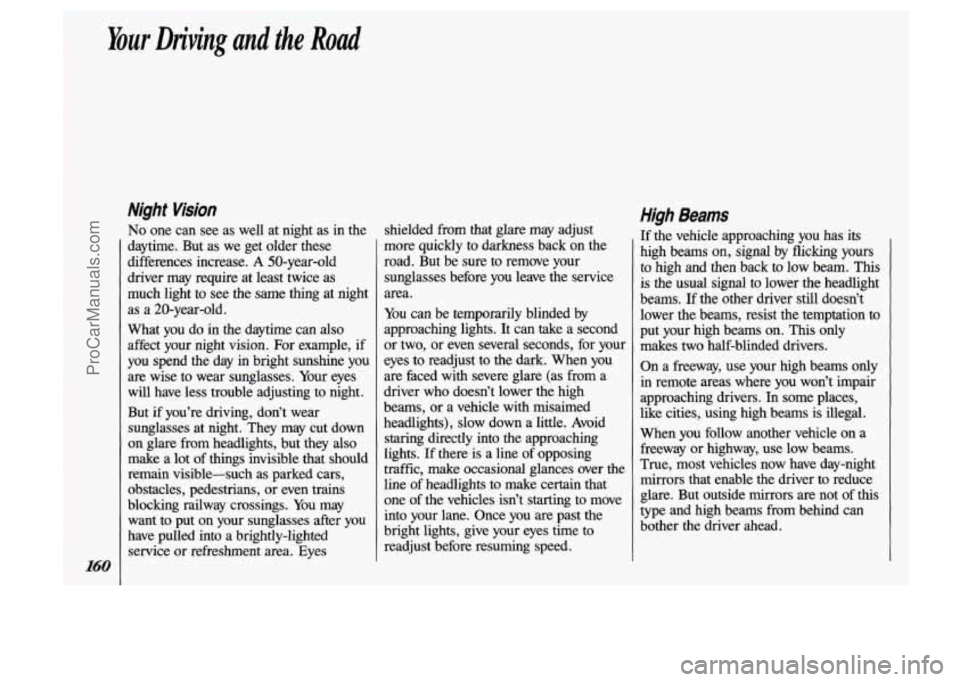
Night Vision
No one can see as well at night as in the
daytime. But as we get older these
differences increase.
A 50-year-old
driver may require at least twice as
much light
to see the same thing at night
as a 20-year-old.
What you do in the daytime can also
affect your night vision. For example,
if
you spend the day in bright sunshine you
are wise to wear sunglasses. Your eyes
will have less trouble adjusting to night.
But if you're driving, don't wear
sunglasses at night. They may cut down
on glare from headlights, but they also
make a lot of things invisible that should
remain visible-such as parked cars,
obstacles, pedestrians, or even trains
blocking railway crossings. You may
want to put on your sunglasses after you
have pulled into a brightly-lighted
service or refreshment area. Eyes shielded from that glare
may adjust
more quickly to darkness back on the
road. But be sure to remove your
sunglasses before you leave the service
area.
You can be temporarily blinded by
approaching lights. It can take a second
or two, or even several seconds, for your
eyes to readjust to the dark. When you
are faced with severe glare (as
from a
driver who doesn't lower the high
beams, or a vehicle with misaimed
headlights), slow down a little. Avoid
staring directly into the approaching
lights. If there is a line of opposing
traffic, make occasional glances over the
line of headlights to make certain that
one of the vehicles isn't starting to move
into your lane. Once you are past the
bright lights, give your eyes the to
readjust before resuming speed.
High Beams
If the vehicle approaching you has its
high beams on, signal by flicking yours
to
high and then back to low beam. This
is the usual signal to lower the headlight
beams. If the other driver still doesn't
lower the beams, resist the temptation to
put your high beams on. This only
makes two half-blinded drivers.
On a freeway, use your high beams only
in remote areas where you won't impair
approaching drivers.
In some places,
like cities, using high beams is illegal.
When you follow another vehicle on a
freeway or highway, use low beams.
True, most vehicles now have day-night
mirrors that enable the driver to reduce
glare. But outside mirrors are not
of this
type and high beams from behind can
bother the driver ahead.
ProCarManuals.com
Page 163 of 323
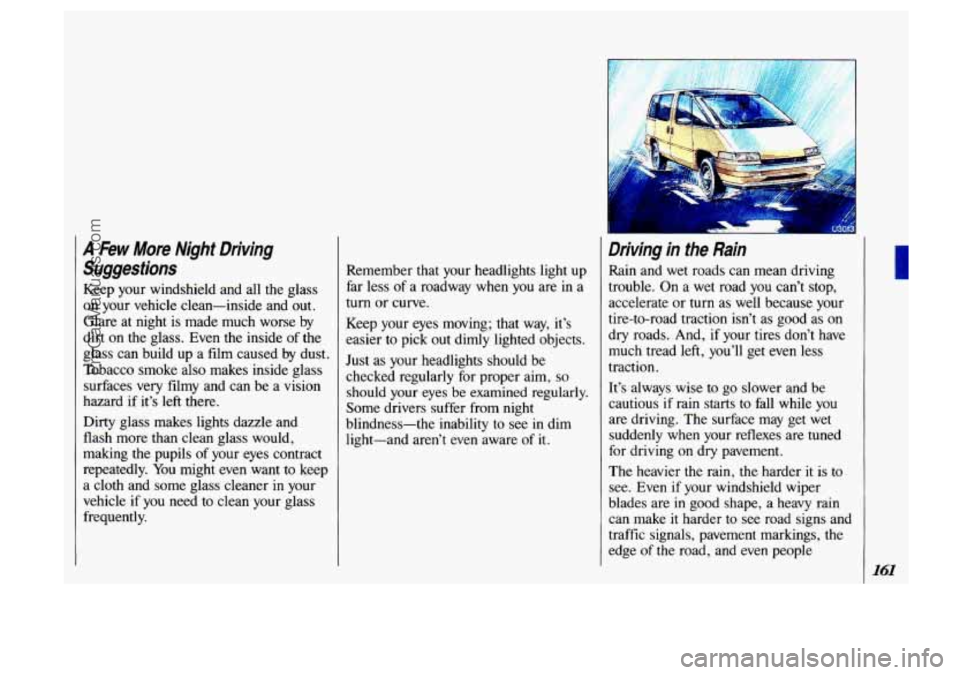
A kw More Night Driving
Suggestions
Keep your windshield and all the glass
on your vehicle clean-inside and out.
Glare at night is made much worse by
dirt
on the glass. Even the inside of the
glass can build up a film caused by dust.
Tobacco smoke also makes inside glass
surfaces very filmy and can be a vision
hazard
if it’s left there.
Dirty glass makes lights dazzle and
flash more than clean glass would,
making the pupils of your eyes contract
repeatedly. You might
even want to keep
a cloth and some glass cleaner in your
vehicle if
you need to clean your glass
frequently. Remember that your headlights light up
far less of a roadway when you are in a
turn or curve.
Keep your eyes moving; that way, it’s
easier to pick out dimly lighted objects.
Just as your headlights should be
checked regularly for proper aim,
so
should your eyes be examined regularly.
Some drivers suffer from night
blindness-the inability to see in dim
light-and aren’t even aware of
it.
Driving in tne Rain
Rain and wet roads can mean driving
trouble. On a wet road you can’t stop,
accelerate or turn as well because your
tire-to-road traction isn’t as good as on
dry roads. And,
if your tires don’t have
much tread left, you’ll get even less
traction.
It’s always wise to
go slower and be
cautious if rain starts
to fall while you
are driving. The surface may get wet
suddenly when your reflexes are tuned
for driving on dry pavement.
The heavier the rain, the harder it is to
see. Even if your windshield wiper
blades are in good shape, a heavy rain
can make
it harder to see road signs and
traffic signals, pavement markings, the
edge
of the road, and even people
ProCarManuals.com
Page 165 of 323
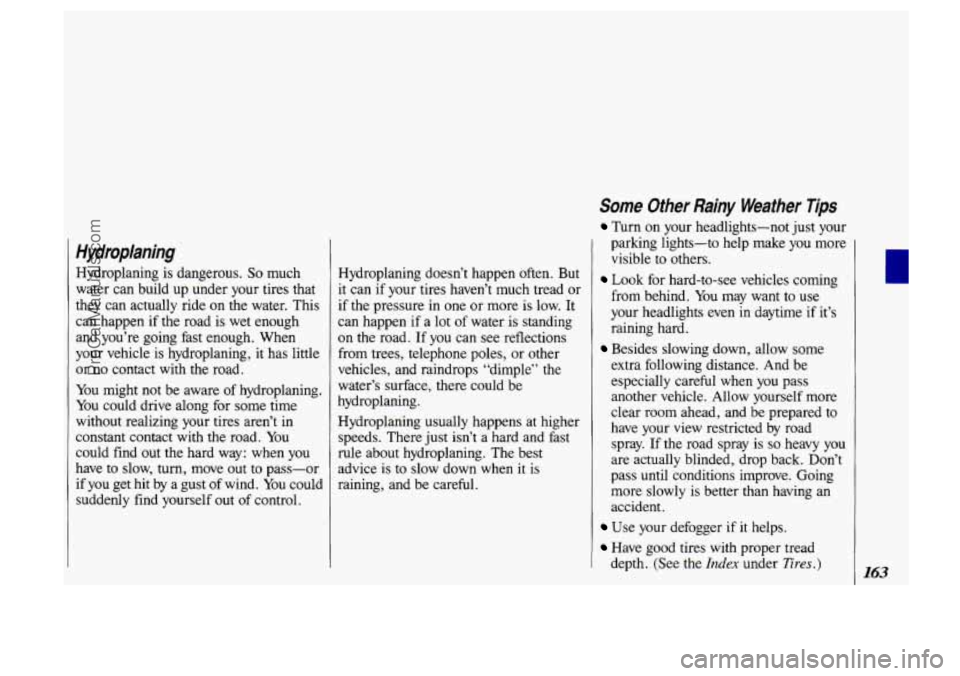
I Hydroplaning
Hydroplaning is dangerous. So much
water can build up under your tires that
they can actually ride on the water. This
can happen if the road is wet enough
and you’re going fast enough. When
your vehicle is hydroplaning, it has little
or no contact with
the road.
You might not be aware
of hydroplaning.
You could drive along for some time
without realizing your tires aren’t in
constant contact with the road. You
could find out the hard way: when
you
have to slow, turn, move out to pass-or
if you get hit by a gust
of wind. You could
suddenly find yourself
out of control. Hydroplaning doesn’t happen often. But
it can if your tires haven’t much tread or
if the pressure
in one or more is low. It
can happen if a lot
of water is standing
on the road. If you can see reflections
from trees, telephone poles,
or other
vehicles, and raindrops “dimple” the
water’s surface, there could be
hydroplaning.
Hydroplaning usually happens at higher
speeds. There just isn’t a hard and fast
rule about hydroplaning. The best
advice is
to slow down when it is
raining, and be careful.
Some Other Rainy Weather Tips
Turn on your headlights-not just your
parking lights-to help make you more
visible to others.
Look for hard-to-see vehicles coming
from behind. You may want to use
your headlights even in daytime
if it’s
raining hard.
Besides slowing down, allow some
extra following distance. And be
especially careful when you pass
another vehicle. Allow yourself more
clear room ahead, and be prepared to
have your view restricted by road
spray. If the road spray is
so heavy you
are actually blinded, drop back. Don’t
pass until conditions improve. Going
more slowly is better than having an
accident.
Use your defogger if it helps.
Have good tires with proper tread
depth. (See the
Index under Tires.) 163
ProCarManuals.com
Page 166 of 323
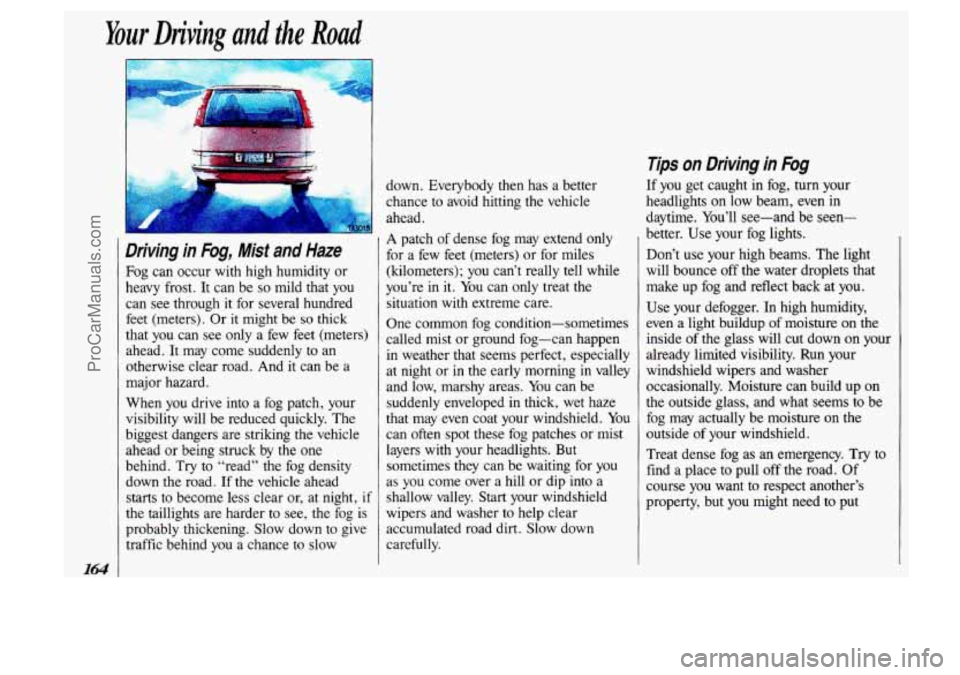
Your Diving and the Road
Driving in Fog, Mist and Haze
Fog can occur with high humidity or
heavy frost. It can be
so mild that you
can see through
it for several hundred
feet (meters). Or
it might be so thick
that you can see only a few feet (meters)
ahead. It may come suddenly
to an
otherwise clear road. And it can be a
major hazard.
When you drive into a fog patch, your
visibility will be reduced quickly. The
biggest dangers are striking the vehicle
ahead or being struck by the one
behind. Try to “read” the fog density
down the road.
If the vehicle ahead
starts to become less clear or, at night,
if
the taillights are harder to see, the fog is
probably thickening. Slow down
to give
traffic behind you a chance to slow down. Everybody then has a better
chance to avoid hitting the vehicle
ahead.
A patch of dense fog may extend only
for a few feet (meters) or for miles
(kilometers); you can’t really tell while
you’re
in it. You can only treat the
situation
with extreme care.
One common fog condition-sometimes
called mist or ground fog-can happen
in weather that seems perfect, especially
at night
or in the early morning in valley
and low, marshy areas. You can be
suddenly enveloped in thick, wet haze
that may even coat your windshield. You
can often spot these fog patches or mist
layers with your headlights. But sometimes they can be waiting for you
as you come over a hill or dip into a
shallow valley. Start your windshield
wipers and washer to help clear
accumulated road dirt. Slow down
carefully.
lips on Driving in Fog
If you get caught in fog, turn your
headlights
on low beam, even in
daytime. You’ll see-and be seen-
better. Use your fog lights.
Don’t use your high beams. The light
will bounce off the water droplets that
make up fog and reflect back at you.
Use your defogger. In high humidity,
even a light buildup of moisture on the
inside
of the glass will cut down on your
already limited visibility. Run your
windshield wipers and washer
occasionally. Moisture can build up on
the outside glass, and what seems to be
fog may actually be moisture on the
outside
of your windshield.
Treat dense fog as an emergency. Try to
find a place to pull off the road. Of
course you want to respect another’s
property, but you might need to put
ProCarManuals.com